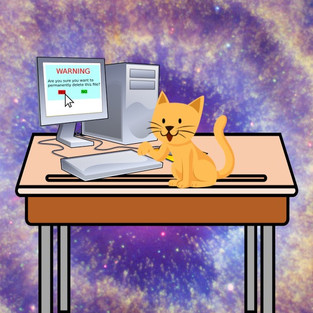4 L3gs & a T@il
- The Natural Philosopher
- Feb 4, 2021
- 3 min read
Updated: Feb 19, 2021
Art by Greg Mcgowan
By Will Jeffries
Although many felines have made an enthusiastic start as independent writers, their inevitable conflict with human users and human software can lead to frustration or minor disasters of lost data and conflicted documents. Certainly, more than one promising author has returned from a coffee break to find their quarantine companion resting comfortably on the computer keyboard, taking a well deserved rest after having diligently applied their - ahem - talents.
No doubt in a sincere effort to improve their owner’s work, our self-made editor may have started by deleting half of the document and leaving in its place some helpful notes such as “dwdadawa”, “pokl;kewrw ds nlk”, or even a well placed “bbbvcvcfd” or two. Oh, and I’m sure you didn’t need that folder labeled “Library”, it was taking up an awful lot of space.
Situations like these were the inspiration for a then 30-year-old software engineer named Chris Niswander, to launch his new business project developing a program that he later dubbed PawSense. This simple yet ingenious piece of software is designed both to immediately prevent, and eventually to actively dissuade, feline interlopers on the keyboard. The original inspiration struck one day when his sister’s cat managed to not only crash a running program, but also completely uninstall several crucial pieces of software from the computer; it was an impressive feat of cathackery for sure. In order to prevent such disastrous results of feline meddling, Niswander’s software works in several stages.
According to the PawSense Facebook page:
“PawSense is a software utility that helps protect your computer from cats. It quickly detects and blocks cat typing, and also helps train your cat to stay off the computer keyboard.”
But exactly how did they manage it?
The first challenge in designing such a software was for PawSense to be able to detect a cat’s presence on the keyboard and to differentiate this from human typing. Counterintuitively, this objective was NOT to be achieved by noting the gibberish produced (since humans are also known for typing gibberish, particularly as stressed out college students). Instead, Niswander designed an algorithm which works on the principle that a cat’s step tends to produce several keystrokes at almost the same moment, such as the letters “q-a-w-s” all typed at once with a deft fall of the paw.
As soon as the software notices this tell-tail sign, PawSense springs into action to defend that nearly-finished bestselling novel (or your art-history essay) by instantly switching to a grey screen which displays the helpful warning of “Cat-Like Typing Detected”, and offering several mouse-click buttons which a human operator can use to return easily to the their un-catified documents.
In addition to preventing one’s feline companion from crashing the Matrix, and thereby saving the owner from a very awkward conversation the next day with their boss/publisher/professor, PawSense goes one step further by working to retrain any furry would-be typists, and dissuade them from future incursions even if humans are out of the room! To this end, PawSense provides the emits audible dissuasions specially designed to repel cats when their presence is detected on the keyboard. Harmonicas and hissing noises are effective defaults that come bundled with the software, but users can also add their own soundtacks for greater effect (or amusement).
Where will such a revolutionary idea go next?
Niswander is already looking to expand across species to include other nuisance keyboard invaders, and has hinted in his webpage’s FAQ that he is looking into the development of “BabySense” to keep those ambitious young coders from getting into too much mischief at the keyboard.
Perhaps as voice-to-text becomes increasingly prominent, there may grow an increasing need for “BeakSense” as an article in the March 2000 edition of Scientific America suggests, in order to combat the excessive addition of “Cracker!” into one’s latest high-profile Tweet.
For anyone interested in securing their computer against feline interference, PawSense works for most Windows operating systems (excluding tablet mode), and is available for immediate online purchase and download at a cost of only $20.
Works Cited:
1. Mirsky, Steve. “c-a-t-t-t-t-t-t-t-t.” Scientific America, Mar. 2000, pp. 26–26.
2. “Pawsense - The Software Utility That Protects Your Computer from Cats.” Facebook, www.facebook.com/PawSense.
3. “ PawSense.” PawSense Helps You Catproof Your Computer, by Protecting against Cat Typing but Letting Humans Use the Keyboard Freely, www.bitboost.com/pawsense/.





Comments